In this topic, we focus on the role of vitamins and their contribution to a nutritious diet.
You will learn:
- the science behind weight loss
- methods of weight loss
- weight loss tips
- exercise options
- exercise and metabolic rate
- motivation and adherence factors
- fat loss supplements
- the 4 steps to change
Terminology and vocabulary reference guide
As an allied health professional, you need to be familiar with terms associated with weight loss principles and use the terms correctly, confidently, and ethically with clients, your colleagues, and other allied health professionals. Weight loss can be a sensitive topic for individuals and it is important you maintain professionalism and ethical behaviour. You will be introduced to many terms and definitions. Add any unfamiliar terms to your own vocabulary reference guide.
Activities
There activities and an automated quiz at the end of this topic. This is not part of your assessment but will provide practical experience that will help you in your work and help you prepare for your formal assessment.

Weight loss, when discussed within the medical, health, or physical fitness industries, refers to a reduction of the total body mass, as a result of a mean loss of fluid, body fat (adipose tissue), or lean mass (namely bone mineral deposits, muscle, tendon, and other connective tissue). The term weight loss refers to a decrease in body weight. Weight loss typically occurs as a result of either voluntary diet and exercise or both. Weight loss is typically sought for either medical or personal reasons, such as to feel physically better or to reduce risk factors leading to diseases such as cardiovascular disease, stroke, mental illness, and many more.
Desired vs undesired weight loss
Desired weight loss would be weight loss which occurs via a health balance of nutritional adjustments and a well-balanced exercise regime. As a fitness professional, your clients will rely on you for guidance and advice around the best strategy for them on an individual basis, this is where you will shine with your knowledge in health and physiology to explain a well planned approach to their weight loss goals.
Weight loss whilst often seen as exciting, should also be monitored, as factors such as poor diet or nutrition, an unbalanced exercise regime or an underlying health condition could lead to undesired or incorrect weight loss. It is therefore important that, as a fitness professional, you hold a strong level of anatomy and physiology and metabolic processes in order to guide your clients safely and effectively through a weight loss regime.
Burning fat
When we lose weight, the objective is to lose/ burn the fat that has been stored within the body. However, looking closely at fat loss, what do we mean when we say “burning fat” where does the fat goes when it is “lost”? If you posed this question to a group of people, a majority of them would take time in processing the answer, if they were able to answer! Is it transformed into heat? Is it transformed into energy? is it release from the body via sweat or does it simply disappear?. The mystery of fat loss is hidden within science…
Fat like other aspects of science, demonstrates the circle of life, how so? Well, in short, plants take carbon dioxide (CO2) and water ( H2O) from the atmosphere and with the aid of chlorophyll and sunlight and series of chemical reactions, this is converted into sugar ( glucose, fructose and sucrose). We then eat these plants and have taken in the sugar. Our bodies break this down and distribute to the cells which require this as energy, any sugar this isn’t digested and metabolised is stored, as fat. In short, thanks to the laws of physics ( which we will not go into- phew!), the conservation of mass states that mass is “neither created or destroyed” in other words, mass (or weight) present at the beginning of a process will still remain at the end of the process, it may have changed form but the mass will remain, as it is not destroyed.
So, when we “burn fat”, what happens?
This 2 minute video below is a summary of the above, discussing the question of ‘where fat goes after it is lost?’
Please note: you are not expected to be able to tell your clients the chemical details but its it useful for you to know in order to be able to grasp the science behind the magic of weight loss.
There you have it! When the body loses fat, more than 80% of it is lost through the air we exhale and 20% through water either when it is urinated or perspired.
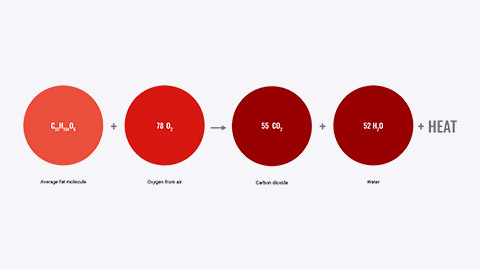
Most commonly exhalation and perspiration take place during vigorous exercise. Sadly, this does not mean if we were to simply breathe more, we would lose weight, we would end up hyperventilating. What it does mean however, through the art of science, with a balance of energy in versus energy out (yes still we must move to burn fat) we can maintain optimal body fat percentages. This is fundamental knowledge that should be shared with your clients at the beginning of their weight loss journey.
Contributions to obesity
As we know, excess weight can lead to obesity. Obesity is a disease that is a result of an excessive amount body fat caused by an imbalance of the calories consumed within the diet and the calories used during exercise or physical activity (energy in versus energy out).
Obesity has become a globally recognized health concern and the increasing number of individuals diagnosed with the condition are also faced with associated health issues such as, cardiovascular disease (heart disease), stroke or diabetes just to name a few.
While obesity is on the rise, it is important to establish an understanding of why it is becoming more and more common. Some of the factors contributing to obesity are listed below.
- sedentary lifestyle
- abundance of food and poor dietary choices
- lack of meaningful exercise
- lack of sleep
- alcohol
- poor advice
- unrealistic weight loss goals leading to repeated failure
- genetics and environment
Note: that majority of these are within our control such as leading a sedentary lifestyle and being mindful of the food types and quantities we ingest however this is where you as the health and fitness professional, can further support your clients by providing them with your knowledge and guide them through their lifestyle choices and assist them in making and maintaining achievable milestones in their weight loss journey, setting them up for success! Let’s have a look at these in more detail below.
Sedentary Lifestyle
A sedentary lifestyle refers to that of little to no physical activity, where an individual spends extended periods sitting or lying down. Some examples of this could include, watching television, playing video or computer games, or the use of a computer or mobile phone whether for leisure or work purposes. This lifestyle is one of the key contributors to weight gain which could then lead to serious health conditions and place them at higher risk of cardiovascular disease or other related diseases. Research has shown that there is a direct correlation between the amount of time people spend sitting and how long they live.
Abundance of food in western culture

Countries with higher obesity rates generally have an over-abundance of food; the more food available, the more people tend to consume. With busy lifestyles, people are often finding themselves time poor; this leads to quick (often poor) food choices as they gravitate towards food of convenience and in this case, a lot of the time there is little nutritional value and these types of foods are usually higher in calories and fat. Convenience always comes at a price!
When too much is available, there seems to be an increase in food waste. In NZ it is estimated the average household throws away nearly $400 of food a year because too much is bought and much of it has not been stored properly and it is not used well. Nationally, an estimated $872 million of perfectly good food is disposed of annually.
Overconsumption of food, especially that higher in saturated fat, can become an active contributor to weight gain and obesity.
Meaningful exercise
Engagement of physical activity plays an essential role in overall health and wellbeing. While many people do engage in some form of physical activity, many are working at lower intensities than required for effective weight loss/health gains. While exercise and physical activity is great for overall health and wellbeing, to make a noticeable impact on weight loss, challenging the body during exercise is key to establishing effective results, again this brings us back to the failsafe concept of energy in versus energy out.
Lack of sleep
Sleep is one of the most fundamental contributions in maintaining overall general health and wellbeing- it is as equally as important as adequate nutrition and engagement of physical activity! It is also one of the strongest factors influencing obesity.
Duration of sleep can affect the body’s ability to appropriately function and can have implications on physical and mental health. There are direct links between shorter sleep duration and an increase in weight gain with studies evidencing people with shorter sleep durations (under 7 hours per night) combined with poor food choices and insufficient meaningful exercise are 2.5 times more likely to be overweight.
Alcohol intake

Many of us like to enjoy an alcoholic drink with our friends and family on special occasions, however excessive alcohol consumption can lead to overall health concerns; one of these being weight gain.
The link between alcohol consumption and weight gain is an on-going study, however, there have been associations with the part alcohol plays as alcohol is high in calories and can have an impact on the body’s ability to burn fat. Alcohol consumption can also result in the feeling of being hungrier than usual and this results in poor food choices, we can all relate to the 2 am kebab on the way home?? It has also been suggested that the body tackles food in a systematic order, in the case of alcohol, the body has to not only burn the calories from our food choices but also the calories in the alcohol we drink, and likely also the addition of the hangover cure of bacon, eggs, sausages, and beans…
Poor advice
As an allied health professional, when you are offering weight-loss advice, it is important you obtain and provide factual information. Individuals who are considering a weight-loss journey are often exposed to trends and fad diets and as a result of seeking advice from unreliable sources. This can influence their choices and the ability to determine the best avenue they should be taking to achieve the best possible outcome for their individual goals. Many people would initially seek their advice from family members or the internet before they consider seeking professional advice. This can become confusing and overwhelming, not knowing where or how to start and can often lead to failed weight loss results. It is important the client is well educated around what is best for their weight loss needs, this is where you, the health professional, comes in!
Unrealistic weight loss goals
Setting a goal for weight loss is one of the first and most important steps in a weight loss journey. Those who are seeking a quick fix for their weight loss have often been exposed to popular reality shows which can give false perceptions of what can realistically be achieved. It gives the impression that large amounts of weight can be lost over a short period of time.
This can be very dangerous not only in relation to physical health but is detrimental to mental health. When results are achieved and seen on others- much like what is being portrayed on reality TV, it can dishearten the individual and result in the return of habits.
As a fitness professional it is fundamental you educate your client in their understanding of weight loss being a journey and a lifestyle change. Your role will be to assist them in setting a realistic and achievable goal. Individual needs are going to be different as will the time in which their weight loss will occur. Slow and steady wins the race! Best results are achieved when the lifestyle changes have taken place slowly and steadily.
Genetics and environment
Genetics refers to the study of genes ( our individual internal blueprint) and heredity of organisms. When looking at humans, genetics can indicate what has been passed on within the family for example, ‘where did my green eyes come from?’ why does my sister have blonde hair and I have brown?’
Genes are the blueprint of the body and these genes are passed through generations, with this being the case, the role of genetics and obesity has also been questioned and studied.
If obesity is common within a family, is it due to the result of genes from overweight parents that have continued to be passed down to their children? Is it due to environmental factors? Is it because the same environment for their children has been created that caused them to become overweight? Or is it a combination of these? Answers to these questions become increasingly difficult to obtain as the separation of genes from the environment cannot be cost effective as the data needs to be collected over a period of time when conducting the experiment.
However, there was a study facilitated with identical twins and the theory behind genetics influencing weight gain.
Identical twin Study
A study was carried out with 12 pairs of identical twins which were taken out of their environment (to rule out any contributing factors from their environment) and they were overfed (in the case of the study, it was an additional 1000 calories per day for a 100 days). Important to note that all twins had no family history of obesity, diabetes or lipid disorders. As identical twins would mean identical genetics their bodies should respond in exactly the same way, no?
The results of the study showed that average weight gain during the study was 8kg (with large differences in weight gain between sets of twins but significantly similar within the pairs).
This study suggests that individuals do indeed have a genetic disposition to storing fat vs lean tissue and there were also significant differences in individuals' use of energy during rest. This, therefore, does indicate strongly that genetics influences weight gain and not only the amount of weight you gain, but where you store it too. What was further identified to support this was the evidence in this study that some people were high lipid oxidisers (fat burners) and some were low lipid oxidisers within the group, despite the same nutritional and exercise patterns over a 3 month period.
This study further suggests that susceptibility to gaining weight with overfeeding and sensitivity to negative energy balance from exercise is influenced by genetics.
However, it is important to recognise that, except in very rare cases, the genes that impact bodyweight do not directly cause obesity. Rather, genetic makeup influences the susceptibility to weight gain when the person lives in an environment that supports eating calories in excess and/or is limiting physical activity.
What was still evident from this study is everyone who overate gained weight and everyone who followed a calorie-restricted diet lost weight.
A key takeaway from these findings is we are all individuals and we all respond differently to over-eating and weight loss practices. That is why people need an individualised approach to diet and exercise- regardless of genetics.
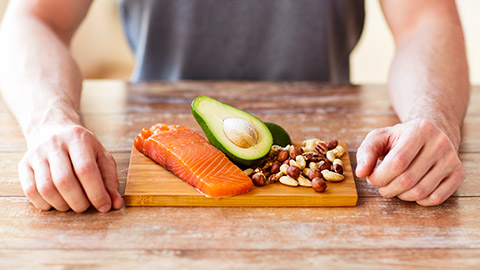
There are many methods surrounding how weight loss can be carried out. There are many approaches to weight loss, in almost all cases, however, restriction of calories in and increase with calories out is fundamental. As a professional, it is important to understand the methods available along with the research that has been compiled to effectively guide your clients in achieving their weight loss goals. Let’s explore a few approaches to weight loss.
Dieting
When referring to weight loss, ‘a diet’ is a practice by which calories are restricted to achieve a daily calorie deficit- (eating fewer calories in a day). There are two generally accepted mechanisms for losing weight, calorie deficit being one and the other being engagement of physical activity.
Diets are goal orientated, which means at some point the design process will lead them to an end result. When you are consulting with a client and establishing their goals, it is vital you emphasise to them that all calorie restriction diets will work in the short term, however, none of them will work long-term. When a goal has been reached, people often return to old habits pre-diet and as a result, the weight creeps back on and the weight loss journey will need to begin again. Not only would this lead to an impact on their physiological health status, but likely ( not always), this will also lead to an impact on their psychological health as the sense of not achieving a goal can be detrimental and further induce “bad habits”.
Eating less
Weight loss is sadly not as simple as just ‘eating less’. For those who are overweight and embarking on a weight loss journey the sudden change in eating less than usual, would be a challenging task. Whilst, however, the purpose of eating less is to aide with a calorie deficit ( energy in versus energy out), if it were that simple and consuming less food was easy, then more people would easily be able to do it. It is not, however, necessarily always a case of ‘choice’ as scientific evidence indicates a hormonal mechanism that relates to regulating hunger- this hormone is called Leptin.
Leptin
Leptin is a hormone that is produced by the body's fat cells. It is often referred to as the "satiety hormone" or the "starvation" hormone.
Leptin's primary target is neurological(acts on the brain) targeting an area called the hypothalamus (a huge controller of the internal balance, homeostasis, of the body). Leptin’s role is to tell the brain that the body has enough fat stored, that there is no need to continue eating, enabling calories to be burnt at a normal rate. Given the way leptin is supposed to work, people should not be eating excessive amounts of food- their brain should know that they have plenty of energy stored. However, in some people, this does not always function as it is supposed to and when the function of leptin is impaired, it can lead to extreme levels of hunger which are virtually impossible to ignore!
How leptin is supposed to work
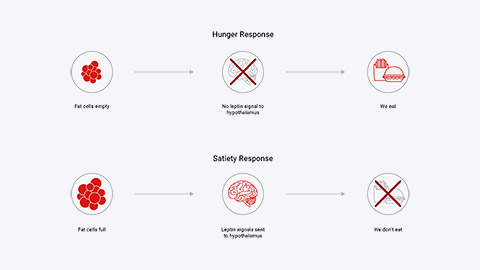
Scientists have recently discovered that in some people the problem is that the leptin signal is not working. There is a lot of leptin in the system, but the brain does not “see” that it is there, this is known as leptin resistance.
Leptin should only be absent in a body if there are no fat cells, so when the hypothalamus no longer recognises leptin, it believes the body may be starving and increases appetite.
To make things worse the brain also thinks we need to conserve energy, therefore it makes us feel lazier and burn fewer calories at rest-( essentially decreasing our metabolism). An individual with this hormone imbalance is faced not only with the issue of extreme and unbearable hunger, but their body receiving the message to retain as many calories as possible. If the individual is unable to withstand the strong impulses to eat, they will, as a result, will gain weight quickly.
Leptin resistance cycle

Leptin functions to turn off appetite while promoting the burning of triglycerides that bloat fat cells. As people accumulate excess fat cells (adipocytes), C-reactive protein is released that binds to leptin in the blood, impairing leptin transport across the blood brain barrier, thus preventing leptin from performing it's dual function of breaking down stored adipocyte fat and controlling appetite. As more fat cells form on the body, greater amounts of C-reactive protein are released, binding leptin even more. This vicious cycle helps explain why aging people often get fatter each passing year.
How can leptin resistance occur?
Leptin resistance can be a result of the following:
- inflammation: Inflammatory signalling in the hypothalamus is likely an important cause of leptin resistance in both animals and humans.
- free fatty acids: Elevated free fatty acids in the bloodstream may increase fat metabolites in the brain and therefore interfere with leptin signalling.
- elevated leptin levels: Having elevated levels of leptin in the first place seems to cause leptin resistance- levels of leptin increase as more fat cells inflate/multiply.
These factors are all heightened with obesity and as a result, a key contributor to the vicious cycle of weight gain and leptin resistance.
However, good news is, this cycle can be improved when considering the following lifestyle modifications:
- avoiding processed food: food that has been highly processed often includes high levels of sugar or refined grains which may compromise the integrity of the gut and drive inflammation.
- eating soluble fibre: increased consumption of soluble fibre (such as fruit- including citrus fruit, vegetables, oats, etc. )can help improve gut health and may protect against obesity
- exercising regularly: frequent engagement in physical activity may help to reverse leptin resistance as it assists with using the calories taken in and prevents them from being store
- sufficient sleep: ensuring enough sleep, (more than 7 hours) as poor sleep has been associated in problems with leptin.
- lowering triglycerides: having high blood triglycerides (stored fat) can prevent the transport of leptin from blood and into the brain. The best way to lower triglycerides is to reduce excessive simple carbohydrate intake
- eating protein: eating plenty of protein can cause help with weight loss. While there are many reasons for eating increased protein one of them may be an improvement in leptin sensitivity along with increasing satiety ( the sense of feeling full)
- sufficient sleep: ensuring enough sleep, (more than 7 hours) as poor sleep has been associated with problems with leptin.
- lowering triglycerides: having high blood triglycerides (stored fat) can prevent the transport of leptin from blood and into the brain. The best way to lower triglycerides is to reduce excessive simple carbohydrate intake
- eating protein: eating plenty of protein can cause help with weight loss. While there are many reasons for eating increased protein one of them may be an improvement in leptin sensitivity along with increasing satiety ( the sense of feeling full).
Manipulating macro-nutrients
When considering a nutrition plan for a client, weight loss can be achieved on calorie-restricted diets regardless of the macro nutrient balance within it. It is important your clients understand that adopting these healthy eating habits will support the change in lifestyle and assist with maintaining these habits on a more permanent basis.
The below 4 diets were compared where the participants were permitted to eat as much as they felt like on the condition, they stuck to certain foods. These diets were a manipulation of macro-nutrients with the research concluding there was a success in weight loss when applying these methods. The diets that were compared were:
- low protein-high GI carb diet (HP-HGI)
- high protein diet (HP)
- low GI carbs (LGI)
- high protein - low GI carb diet (HP-LGI)
Post research indicated that the only diet that was successful in terms of losing or maintaining weight beyond 12 weeks was the HP-LGI diet with those on the LP-HGI diet gaining the most weight. Scientific evidence suggested a high protein - low GI carb diet works best not only for initial weight loss, but also for maintenance. If you are advising your client to consider a high protein diet, you will need to ensure they understand the daily recommended calories they should be consuming. Enriched high protein diets have people usually consuming between 25-35% of their calories in protein. In reality, many western diets already hit these numbers.
The following graph illustrates the findings of individuals who had participated in both high protein and high carbohydrate diets. The results concluded that the participants in both groups lost weight, however, those following the high protein diet were more successful in both short and long term weight loss.
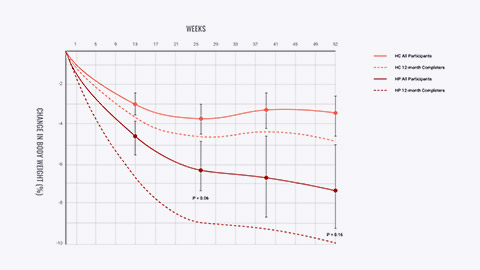
Why is protein thought to be an effective weight-loss tool?
There are many reasons surrounding the success, however, the following are some of the most important:
- protein is the most satiating hormone because it remains in the stomach for longer than other macronutrients and this makes it easier to avoid over-eating as you are feeling full, reducing both hunger levels and desire to eat.
- protein uses more calories to digest than the other macros, about 25% of protein calories ingested are used to break down protein for absorption (when eaten in food form)- this compares with carbohydrates (6%) and fat (around 2%).
Additional benefits: A high protein intake increases the chances of maintaining good levels of Iron intake (energy levels) along with levels of other micro-nutrients such as B12, Folic acid, calcium.
While there is some compelling and well-evidenced research supporting a high protein diet for weight loss, not all research suggests this is a necessity for weight loss. If we simplify things and ask the question "are protein calories better than carbohydrate calories for weight loss?"...then the answer may not be so clear cut.
While there is some compelling and well evidenced research supporting a high protein diet for weight loss, not all research suggests this is a necessity for weight loss. If we simplify things and ask the question "are protein calories better than carbohydrate calories for weight loss?"...then the answer may not be so clear cut.
A review of this theory presented the following vital findings:
- under planned isoenergetic conditions (same calorie intake), both high protein-low carbohydrate (HPLC) and low protein - high carbohydrate (LPHC) dietary patterns resulted in similar weight loss and changes in body composition. The HPLC diet may offer clinical benefits to people diagnosed with obesity in relation to insulin resistance. However, the increase in LDL (bad) cholesterol with the HPLC diet suggests that this method should be closely monitored.
- participants lost more fat than lean mass after consumption of all diets, with no difference in changes in body composition, abdominal fat, or hepatic (liver) fat between assigned macro-nutrient amounts.
- reduced-calorie diets resulted in clinically meaningful weight loss regardless of which macronutrient they emphasise. The key was maintaining a calorie deficit diet this is where the high protein group may have had benefits as they reported higher levels of feeling full and lower hunger scores than the high CHO group.

As a health professional, you are in a position to provide your clients with quality, educated advice when assisting them with what dietary approach they should take, as well as their appropriate levels of physical activity. When doing so, it is important to listen to gain an insight into their lifestyles and interests and take these into account when providing them with advice and possible strategies they will be able to both incorporate and maintain in their lifestyle.
Below are some valuable sources of scientifically verified information regarding weight-loss advice tips.
Eating more soups
Discussing the option of introducing more soups as part of their diet, could be a gentle starting point with a client. Scientific discoveries have been made where the same ingredients from their solid form are ingested into the body in the form of soup, the body can obtain significant differences in gut emptying rate and fullness. However, diets that are solely based on soups, are considered to be of short-term benefit and are generally carried out over short periods of time.
It is important to clarify some soups are more beneficial than others, with consideration of the amount of protein and or carbohydrate (addition of pasta or starchy vegetables) present. Some soups may have higher calorie content (such as creamy based soups) which will affect the daily calorie intake advised.
Quantity of meals
There is considerable debate over the quantity of meals that should be consumed a day. Taking into consideration the level of physical activity a client may be partaking in will have an impact on the number of meals they should be able to ingest throughout the day. For example, more than three meals may be appropriate for active workers or athletes engaging in consistent physical activity multiple times a day for fuel and refuel.
If your client is seeking weight loss, it would be more beneficial for them to be consuming 3 appropriately planned meals a day and avoiding snacks (weight-loss clients generally have a history of overeating). Those looking to lose weight will need to teach their body to learn to manage without being fed every hour or so, as creating larger gaps between meals means the body will have no choice but to start to use the fat as a fuel source.
Fundamentally, the key to weight loss is to ensure total calorie intake (energy in versus energy out) is appropriate for your client.
Fasting
Fasting refers to the cycle of which the body experiences a prolonged period of time without food with the objective being, the use of fat sources as energy.
Some individuals who decide to partake in a fast may choose to do so over a 12-hour period of time. In this case, if their last meal were at 7 pm, they will not eat anything between 7 pm and 7 am the following morning- (the same method could also be applied over 16-hour period)
While this method has been shown to be a very effective way of reducing body fat and improving health markers like blood sugar control, it requires an enormous amount of psychological discipline. This will also need to be factored in if this is going to be advice you are planning on giving your client.
It is important to consider when advising a client of this weight-loss method, it may not suit everyone- especially those who are overweight. It would be unrealistic to expect a client who has led a lifestyle of constant overeating, to suddenly stop eating for a prolonged period of time. There is also the possibility of underlying health concerns that will need to be carefully factored meaning fasting may not be ideal. Some examples of underlying health concerns could be those with diabetes as well as those on special medication. If fasting is a method you are considering, the client should seek medical advice from a general practitioner to ensure there are no additional underlying concerns that could have serious implications on their health, they should also be encouraged to discuss the prospect of fasting with their G.P.
Frequent Snacking
When you are consulting with a client regarding weight-loss, snacking may be an important part of the consultation you will need to factor in. There is a difference between feeling truly hungry or snacking due to boredom or existing habitual snack times.
If you are advising snacks as an option for your client, consider the choice of snack and the implication on the number of daily calories that have already been calculated. Too many snacks can sometimes affect the balance of ‘calories in’ and meals will need to be adjusted to ensure the balance is maintained.
Calcium
Calcium is a vital mineral required by the body in order to maximise functionality. While many properties of calcium support bone strength and density, muscle tissue, and nerve function (just to name a few). Recent findings have found that calcium also plays a role in weight loss! Calcium found in dairy products; milk, cheese, yoghurt as well is in fruit vegetables- such as broccoli, spinach, kale, oranges, figs, blackberries, and beans like soybeans, green beans has proven to be a fat burner.
Take a short break from the reading and check out the video to find out more about how calcium can be used in weight loss.
Portion size

Portion refers to the amount of food that an individual consumes. When offering advice in terms of weight loss with your client, emphasising the importance of portion sizing will be of benefit to ensure a calorie deficit is met daily. The client needs to be aware of how much is consumed at each mealtime. Typically, the more food we put in front of us, the more we will eat and the longer it sits there the more likely you are to pick at it. Think about all of those grazing boards sitting in front of you at a party!
Below is a list of some helpful tips you could offer to your client with relation to portion size:
- use of smaller plates: by using a smaller plate, gives the idea that you are eating a larger whole plate of food
- halving the portions: advise your client that halving what they normally would consume could assist in eating less in one sitting
- meal preparation: also known as meal prep, can help with organisation and convenience as the meals have already been portioned with the recommended balance of protein and carbohydrates
- calorie counting: advising your client to monitor the number of calories that are present in their food can assist with the portion size- meal prep is a great way of combining calorie counting in conjunction with portion size.
- logging meals: clients are able to track their calorie intake as well as what they are eating by keeping a log of their meals. This can either be in a fitness journal or with modern technology by logging their meals on an app for example- My Fitness Pal.
Fish oil
Fish Oil is developed from fatty fish and is rich with omega 3 and omega 6 fatty acids which are essential fats for the body. Fish oil has many benefits for overall health and well-being including support with cognitive function, improved cardiovascular health, reduced inflammation and has benefits on the joints- not only that, it has also been linked to supporting weight loss- all of these benefits in one small capsule!
Some of the ways in which fish oil can support weight loss are listed below:
- omega 3 found in fish oil assists with satiety and reducing the hunger cycle- which is great when trying to lose weight as the individual will be less likely to overeat.
- anti-inflammatory properties within fish oil have been evidenced to reduce the inflammation pathways
- omega-3 reduces the accessibility and delivery of fatty acids and reduces fatty acid fusing enzymes; this helps to restrict the formation of triglyceride molecules (lowers triglyceride)
- reduces size and number of fat cells in a safe and effective way
It is advised to take one tablet over different times throughout the day as the fatty acids may result in nausea and the possibility of acid reflux. There are some recommended times in which fish oil should be consumed in order to maximise the role in which it plays in weight loss; these include:
- 30-60 minutes after waking up
- 30 minutes before lunch
- 30 minutes before going to bed
If fish oil is being offered as a supplement, it is recommended the client consult with a general practitioner prior as this will assist with the dosage in which they are able to take. It is also important to note that the effect on fish oil as weight loss will have various results on individuals and their lifestyles.

While adjustments to eating habits and lifestyle changes are made in relation to weight loss, these factors do not act alone. Exercise has been identified as the number one predictor in weight loss success.
Maintaining a regular exercise regime in conjunction with a healthy diet plan will assist with improving overall health and physical well-being along with actively supporting weight loss. As a professional, you will be able to advise your client in both their diet and exercise goals by carefully suggesting a plan that will enable both of these weight loss strategies to occur cohesively and successfully.
There are some theories around for exercise options and some of these include:
- no exercise: no engagement in physical activity with focussing weight loss solely on a balanced diet
- diet and aerobic exercise: combining both a healthy, balanced diet with cardiovascular physical activity to achieve weight loss goals
- diet and resistance exercise: combination of diet and exercise involving muscular strength and endurance achieve weight loss goals
- diet, aerobic exercise and resistance exercise: combination of diet and exercise regime involving cardiovascular and muscular endurance achieve optimal weight loss goals
- metabolic circuits: emphasis toward physical activity that mixes endurance training with high intensity cardiovascular training; this supports achievement with fat burning along with muscle building.
Diets
While diets have proven to have positive results in weight loss, a lot of the time this is a short-term achievement. However, when certain goals have been met, people often become comfortable and return to poor nutritional eating habits, therefore, the long-term results are not met. This is where you, the professional, can educate your client in this being a lifestyle change of both regular healthy eating and physical activity for overall physical health and well-being.
FUN FACT
It is said that for every 1kg lost when dieting, 30% is muscle weight and 1% bone weight. This shows the importance of maintaining resistance training while dieting.
When in the initial stages of implementing ‘the change’- this being that of diet, exercise and overall lifestyle with your client, there are 4 steps which will need to take place in order to maximize their overall participation and motivation. This involves rewiring the metabolism.
The 4 steps to change
- Step 1 (week 1): Remove undesired habits and poor food choices- this includes food high in sugar and high saturated fat and replace them with more desirable lifestyle habits and nutritionally balanced food- particularly food with rich protein value
- Step 2 (week 2): Increase consumption of nutritional foods and with emphasis on portion size and their appetite
- Step 3 (week 3): Re-ignite metabolism by increasing exercise levels- more engagement in physical activity- including aerobic/ cardiovascular, metabolic circuit training
- Step 4 (week 4): re-balance mood – focus on sleep, motivation , mind-space
Your clients are more likely to adhere to a new routine if changes are made subtly and gradually rather than bombarding them with unrealistic lifestyle changes and exercise programs. You will be able to gain more successful and meaningful results from them with the appropriate levels of support, encouragement, and most importantly motivation!
Cardiovascular physical activity
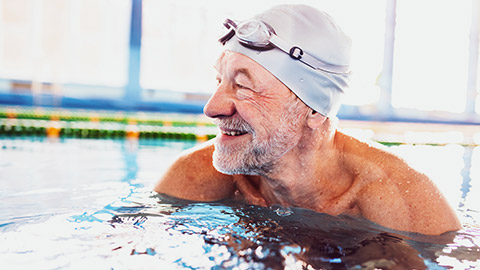
Cardiovascular training (cardio) or aerobic training refers to physical activity that focusses on the function of the heart, lungs and blood cells. Oxygen is circulated around the body through the blood, to aide in working the larger muscle groups and muscle tissue to produce energy. Engagement of cardiovascular training usually occurs for a length of time ranging anywhere between 5-10 minutes or 30-120 mins (approximately). The objective of this sort of training is to support weight loss, increase stamina and endurance.
There are different styles of cardiovascular training which an individual may undertake, some of these include:
- long-distance cardio: which is engagement of physical aerobic exercise over 40 minutes
- high-Intensity Interval Training (also known as HIIT): this level of training involves alternating between spells of high-intensity exercise and low-intensity exercise- for example, a 1-minute sprint and a 1-minute walk on a treadmill. HIIT effectively burns calories not only during exercise but post physical activity as well.
- cardiovascular physical activity carried out either inside or outside of the gym: this could be walking, jogging, running, cycling, swimming, using a rower, skipping just to name a few!
Benefits of cardiovascular physical activity
In conjunction with benefits on overall physical health and wellbeing, cardio-based physical activity has many other benefits that will assist with weight loss on a long term basis. Some of these include:
- improved glucose/insulin & triglyceride control
- consumption of energy both during and after the physical activity
- aerobic modes of exercise - walking, jogging, cycling, swimming - are the most accessible form of training for most over-weight or obese individuals and do not always require the need for a gym.
The benefits of cardiovascular based physical activity on a whole-body level are abundant. Aerobic training increases cardiovascular function, aerobic capacity, basal metabolic rate, and fat metabolism. In conjunction, it supports producing changes in eating behaviours that may reduce energy intake with an individual with undesirable dietary habits. Such changes in whole body metabolism and dietary habits induced by regular aerobic exercise, are undoubtedly beneficial to promote weight management. Aerobic exercise can also elevate muscle protein synthesis and elicit modest increase in muscle mass.
Guidelines for aerobic exercise
When developing guidelines for aerobic exercise it is important to note, these are not ‘starting’ recommendations, but rather something to work towards. Ideally, it should be built up to over 200 mins of accumulated aerobic exercise a week with the exclusion of resistance training. It should also be mixture of long, slow and shorter bursts of exercise according to whatever fits the schedule – but it should at least include 1 longer session a week. When considering a workout zone, it is recommended it appears to be 65-70% of maximum effort.
Resistance/ weight training

Weight training (or resistance training) is defined as a type of strength training that uses weights as resistance. Just as aerobic physical activity increases strength and conditioning on the heart, weight training places necessary stress on the muscles which causes them to become stronger. This style of training can be performed with free weights which include barbells and dumbbells or by using weight machines at the gym. Weight training, however, is not restricted to equipment used at the gym, however, resistance can also be achieved with bodyweight with squats, push-ups, lunges, and resistance can be challenged with the addition of a band whilst performing these exercises.
Studies have concluded that a weight loss regime that combined resistance training with cardio and a nutritionally balanced diet had a marked effect of fat loss.
The question remains, how does the engagement of resistance physical activity result in weight loss without the addition of cardio and consideration of diet?
Effect of resistance training on weight loss
- increased myofibrillar protein synthesis: an enhancement of the sensitivity of amino acids from protein.
- Increased muscle mass.
- continues to use energy during and after training
- although resistance training retains or improves the relative quantity of lean tissue to total body mass, the low energetic requirements associated with this type of exercise typically results in only moderate effects on weight loss.
- demonstrated an increased lean mass with resistance training compared to aerobic training; however, resistance training failed to promote loss of fat of a similar level to aerobic training and consequently, resistance training group gained weight.
A study was carried out in the USA in relation to the effectiveness of training regimes best suited to weight loss. It compared weight training vs cardio and looked at the influence of exercise on physiological markers and performance changes with weight loss in men.
Subjects were assigned to three groups of strategies designed to target weight loss in regard to their overweight condition (training was carried out over 3 x weekly from 30-50 mins over 12 weeks)
Strategies implemented were:
- diet only
- diet and aerobic exercise
- diet, aerobic exercise, and weights
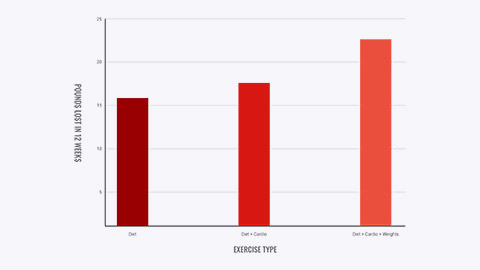
Study results
The results of the study concluded that in the 12-week period:
- the diet group lost 14.6lbs (6.6kgs) of weight- 67% of weight lost was fat.
- the aerobic group lost 15.6lbs (7.07kgs) of weight- 78% of weight lost was fat.
- weight training group lost 21.1lbs (9.5kgs) of weight 97% weight lost was fat.- (that is 44% more than the diet group and 35% more than the diet and aerobic group)
Further research was conducted on 119 sedentary, overweight/obese adults that completed an 8-month exercise protocol in one of the following 3 groups and primary outcomes included total body mass, fat mass, and lean body mass.
- resistance training 3 days a week, 3 sets of 8-12 reps for 8 exercises (60 minutes).
- aerobic training 3 days per week for 40-45 minutes (6.4km per session) at 80% HR max.
- aerobic and resistance training (a combination of the above).
Study conclusions
This study indicated:
- primary finding: When participating in resistance training in isolation (without aerobic or diet combinations), the effects on fat metabolism are modest but its role in retaining/increasing muscle mass is invaluable.
- resistance exercise has been ineffective at reducing the fat stored in the abdominal cavity (visceral fat) when compared with aerobic exercise.
- the group which took part in a combination of both aerobic and resistance training saw a greater reduction in total body and fat mass than the group engaging in resistance training alone.
- the combination of resistance training and aerobic combined and resistance training in isolation both training groups showed increased lean body mass more so than aerobic training.
- balancing time commitments against health benefits, it appears that aerobic training is the optimal mode of exercise for reducing fat mass and body mass while a programme including resistance training is needed for increasing lean mass in middle-aged overweight/obese individuals.
Guidelines for exercise and weight loss upon review
The recommended guidelines for weight loss after reviewing concluded:
- moderate-intensity aerobic exercise between 150 and 250 minutes per week (30-50 mins 5 days a week) will improve weight loss than in studies that used moderate diet restriction but not severe diet restriction
- greater amounts of aerobic exercise (225-420 mins per week/60 mins a day) was associated with clinically significant weight loss.
- Resistance training does not enhance weight loss but may increase fat-free mass and increase the loss of fat mass and is associated with reductions in health risk.
- resistance training guidelines: 2-3 sessions a week, 8-30 reps, target major muscle groups, 30-60secs rest between sets. The focus should be on calorie burn and therefore multi-joint exercises targeting multiple muscles.
The role of metabolism
Metabolism is the body’s chemical ability to convert food into energy. The higher the rate of metabolism, the faster the body is able to convert food into energy and use it as fuel, conversely, the slower the rate of metabolism results in the body’s ability to take longer in converting food to energy. In the case of those with a lower metabolism, ‘energy in’ would need to be carefully monitored because it essentially takes their body longer to use the calories as fuel and can more easily result in weight gain.
Studies have shown that different forms of exercise influence various effects on metabolic rate post-exercise. Informing your client that exercise not only burns calories during engagement of physical activity, but it also continues in the hours after exercise, is very valuable information and may assist with motivating your client’s participation in exercise.
The following information details how various forms of exercise affect the ‘after burn’ of calories.
Non-Exercise Activity Thermogenesis (NEAT)
NEAT essentially refers to the energy expended during the day for all we do this is not exercise, sleeping, eating, or sport-type engagement. It refers to time spent moving around while at work, (walking to the photocopier), outdoor work such as landscaping/gardening, even fidgeting. While individuals are still moving throughout the day, is it enough to lose weight?
Maximising the metabolic effects of exercise
Metabolism is effectively your body’s rate of burning fuel. This increases during engagement of physical activity and, with certain types of exercise, can continue to burn fuel post-training, yay!
So, which mode of exercise gives the greatest calorie burn? To best answer this, the metabolic effect needs to be understood, this will help when explaining the importance of participating insufficient physical activity.
Excessive post oxygen consumption (EPOC)
Excessive post oxygen consumption is the increased use of oxygen(O2) use in the period after exercise- has been referred to as the ‘grand measure’ for metabolic conditioning.
For every 1L of oxygen consumed (over and above resting levels), 5cals are burned. Therefore, the longer you continue to use oxygen at an elevated rate following exercise the more ‘energy out’ (the more calories burned). When factoring the burn of calories both during and post exercise, some modes of exercise will be more effective than others.
Some of the more effective modes of exercise include:
Light to moderate exercise
Light to moderate exercise refers to the engagement of physical activity where the body participates at a lower intensity. This could include a light walk or bike ride for leisure purposes. To amplify this to a more moderate form of exercise, the intensity would be increased gradually. However, whether exercise is light or moderate, when the body begins to engage in physical activity, the body experiences a little shortage of oxygen, this consumption continues at an elevated rate until exercise ends. Once exercise finishes, the body continues to consume the oxygen at an elevated rate for a short time after. This rate of additional O2 usage diminishes the further you get from the exercise session.
Vigorous exercise
Heavy/ vigorous exercise refers to the engagement of physical activity where the body participates at a high intensity. Some examples of heavy exercise may include, running, skipping, or swimming. In this case, when the body engages in higher intensity of physical activity, it goes into a much greater O2 debt, this is conversely reflected in the length of time you stay in EPOC after exercise. Essentially, the higher the training intensity the more calories that will be burnt both during and post-exercise.
A series of studies were carried out with participants engaging in physical activity where intensity, duration, intervals (both long and short), continuous training, resistance, and cardiovascular training all took place. Each of the following graphs outline the comparisons between the different exercise intensities and their effect on EPOC. Have a look at the graphs below and become familiar with the different outcomes/ effects of each style of training.
Importance of intensity
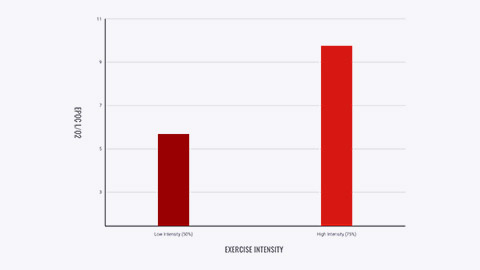
This study was carried out with 2 groups that performed different intensities of aerobic activity (cycling). The study concluded the volume of EPOC gave different results in the amount of calories used.
Low-intensity groups (50% VO2 max) vs high Intensity (75% VO2 max). The energy cost of both exercise bouts was 500 cal. Results obtained ver the same short post-exercise time frame showed:
- low intensity group: EPOC = 4.8L, 24 cal.
- high intensity group: EPOC = 9.0L, 45 cal
Findings:
- higher intensity caused a 187% increase in EPOC
Duration of exercise
The duration of exercise also has an impact on the amount of calories used.
The graph below outlines the durations of 30mins, 45 mins, and 60 mins of physical activity along with the calories burnt by the participants.

This study was aimed at analysing the effect of exercise duration (30, 45, and 60 min) at 70% VO2 max and was compared against EPOC. Results finding:
- 30 min: EPOC of 6/6L (33 cal in 128 min)
- 45 min: EPOC of 14.9L (74.5 cal in 204 min)
- 60 min: EPOC of 33L (156 cal in 455 min)
Findings:
- increasing exercise duration significantly increases EPOC (particularly in the last 15 mins).
Interval exercise vs continuous exercise

These are the results of the effect of a continuous run (30 mins at 70% VO2 max) vs an interval run (20 bouts of 1 minute duration at 105% VO2 max with 2 min rest between each).
- Continuous: EPOC = 6.9L (34.5 cal)
- Supramaximal(intervals): EPOC = 15L (75 cal)
Findings:
- Significantly greater EPOC in intermittent bouts of supra-maximal exercise.
Longer intervals
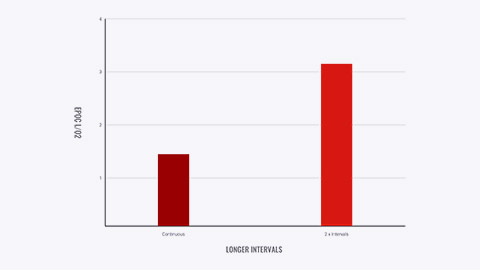
This study shows the results from comparing two 25-minute separate runs at 75% VO2 max (subjects return to baseline VO2 between each) to one fifty-minute continuous run at 75% VO2 max.
- Intermittent session: EPOC = 3.1L (15.5 cal)
- Continuous session: EPOC = 1.4L (7 cal)
Findings:
- Significantly greater EPOC recorded following an intermittent bout of exercise.
Resistance training vs cardio
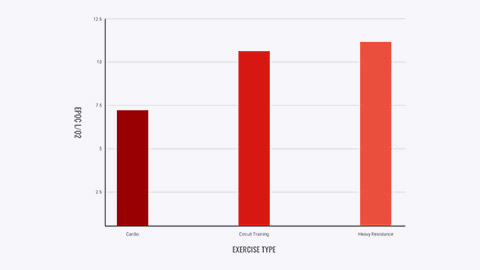
This data reflects the results of EPOC compared when exercising aerobic cycling (40 minutes at 80% maximum heart rate)
- Circuit (4 sets, 8 exercises, 15 reps at 50% 1RM)
- Heavy resistance training (3 sets, 8 exercises, 3-8 reps at 80-90% 1RM)
- Heavy resistance training: 10.6L (53 cals)
- Circuit Training: 10.2L (51 cals)
- Aerobic Cycling: 6.7L (33.5 cals)
Findings:
- High-Intensity strength training has the most profound effect on EPOC (10RM)
EPOC duration
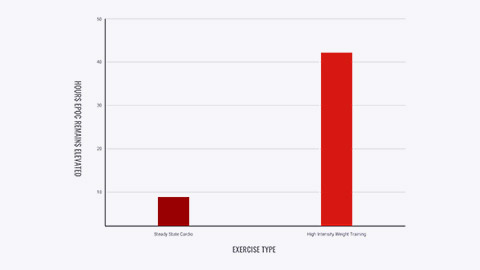
Examining the duration of EPOC after a high intensity 31 min resistance training bout which included:
- 4 circuits of 10 reps at 10 RM to failure
- bench press, power clean and squat
- 2mins rest between exercises.
Findings:
- O2 consumption was significantly elevated above baseline values at the immediate post, 14, 19, and 38 hours post-exercise, compared with steady-state cardio of the same duration - Up to 7.5 hours max.
- high-intensity strength training has the most profound effect on EPOC (10RM) when compared with steady-state cardio.
Key information to consider with your client:
- train above 70% VO2 max for the highest EPOC effect.
- longer is better for the EPOC effect.
- use high-intensity cardio intervals vs continuous exercise.
- 2 shorter workouts produce higher EPOC than 1 long one
- use high-intensity strength training over cardio for EPOC.
- high-intensity strength training is superior to cardio for fat loss.
- high-intensity training has a greater effect on both VO2 max & anaerobic capacity than steady-state cardio
As much as we would like our clients to have reasonable expectations on their end results, you, as the professional also need to be realistic with your client’s capabilities. Be mindful that many new clients will not be able to train like this and you do not want to unintentionally set them up to not succeed. Primarily, your first job is to improve their ability to perform the exercises and slowly and safely create a logical and effective journey to reach their exercise goals. Making an exercise regime that is unachievable for new clients will likely dishearten them as they will not see the possibility of success, they are unlikely to maintain their regime and you will possibly lose the client. You will need to establish their confidence, gradually, with realistic goals they can achieve. The balance is maintaining these realistic goals while challenging them, especially if they are new to exercise.

In the professional role of a personal trainer, one goal is to support and help the client achieve their desired outcomes. In the case of weight loss, there is much more to think about when supporting client needs. Simple advice in nutrition and exercise is one thing, but they will need assistance in maintaining motivated, focused and adhered to their new lifestyle change if they are to see results in weight loss.
One important thing to consider is that new exercise regimes and diet plans can become extremely overwhelming. If these new changes are not facilitated carefully for a client, they can have an impact on their motivation levels.
Be mindful that many clients may never have set foot in a gym in their life and consulting with a trainer could potentially be quite intimidating. Often clients are self-conscious, therefore, ensuring there is no judgement will help them feel comfortable. By building a positive rapport with a client, it will assist in building their confidence and influence their own levels of motivation. The end goal should be to have the client to not need motivation from a professional any longer as they are now able to motivate themselves to stick with what is needed to achieve weight loss.
Let’s have a look at a hypothetical scenario below, paying close attention to the dialogue of Chad, the trainer with his client, Evelyn, and how his communication impacts her.
Scenario
Evelyn is a 37-year-old woman, she has entered the gym for the first time in her life and is looking a little uncertain. She has arranged a consultation with Chad, one of the trainers at the gym, to assist her in developing a weight loss plan and exercise regime.
During Evelyns’ consultation with Chad, he asks her if she had ever been to a gym before or if she has had any experience with weight loss programs. Evelyn confirms this is her first experience at the gym and is unsure of where to start. Chad begins to take note of her weight (80kgs) and height (155cm) and asks her what her end goals are. Evelyn tells him she wants to lose at least 20kgs. Upon hearing this Chad advises that she will need a controlled diet, regularly perform a mix of intense cardiovascular training, intervals, metabolic circuits, and resistance training. He explains that is she is able to train multiple times a day, at an intense level for long periods of time she will lose a significant amount of weight.
Evelyn, politely thanked Chad and informed him that she will be in touch with him when she is ready to start her training regime.
In this scenario, while intentions were genuine, Chad had subconsciously demotivated Evelyn before she could even begin her journey. She was overloaded with information.
As she had never been to a gym before and she has just been advised to participate in copious amounts of exercise in order to achieve her goal, she was deterred to commence as it may have seemed unachievable.
A different approach could have been taken by Chad to help understand the client's potential and capabilities. The plan can commence with a steady approach with long term achievements that can be maintained in the future. Remember, a trainer should focus on lifestyle change for their client, not create a quick fix!
Let’s take a closer look at preferred approaches for clients seeking assistance with weight loss.
Motivation! This is the key word in reversing obesity- as a fitness professional, this is one of the most fundamental aspects you can offer to your client at the commencement of the weight loss journey. However, it is important to eventually have the client motivate themselves. As there are many aspects of their lifestyle that needs to change, they need to maintain motivation without relying on another person. Being able to inspire themselves to regular exercise and persevere with modified diet will see them to achieving their goals.
When introducing new changes to a client, it can start by initially making the changes small and achievable. It is crucial that everything does not change all at once - this includes exercise. By gradually building the intensity of an exercise, it will allow the body time to adjust to the new stress on their body from the exercise performed.
A clever way to approach a new exercise regime is to choose modes of exercise that are most enjoyable for the client. In time, results, even small ones might encourage the client to push themselves harder to continue in seeing weight loss results rather than giving up.
For those clients that are likely to quit, it is important to remind them of why they started in the first place.
If your client can only commit to 1 or 2 sessions a week at the gym, though it is not the best if they wish to see fast results, any start in the right direction is better than none at all.
It can be viewed as an introduction to their new lifestyle, they will need to be informed that them for best results, their activity will eventually need to increase and become more challenging.
Improving adherence
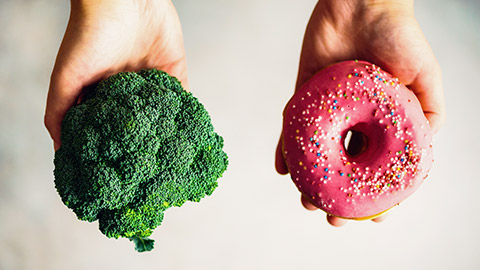
Firstly, a client will need motivation, after that, they will need to have adherence. This means they need to stick to these new changes and continue improving on them to see change and to maintain their results. A client needs to be dedicated to their training, and the strategy taken needs to be constructed in such a way to them in their exercise routine.
It is important to recognise that weight loss is not an easy journey for most, nor is maintaining the results. There are however many success stories from individuals who have maintained a healthy lifestyle because they have gradually implemented a change of habits.
See what habitual changes can increase the chances of the client to improve their adherence to their new lifestyle below:
- self-awareness: Monitoring their behaviors to make sure they can maintain discipline in their implemented changes.
- self-motivation: relying on themselves to keep pushing forward and not to revert or give up.
- social support: family, friends, and professionals to have as a support network that follow and encourage their journey.
- autonomy: driving independence for determination in success
- being responsible: assuming responsibility
- psychological strength: having mental stability and strength and being realistic with results
- resilience:better coping strategies such as confronting their problems rather than turning to food for comfort
- goal driven: self- determined to reach weight goal and being self- disciplined
- eating habits: eat regular, healthier meals, controlling overeating and not feeling guilty when eating a naughty meal from time to time.
Research was conducted on over 10,000 people who have lost significant amounts of weight and kept it off for long periods of time. They were surveyed to determine their secrets in adhering to their lifestyle changes and the results show many common denominators. In order to maintain their weight loss goals have maintained 250 mins of aerobic exercise a week .
Below you will find more data on these researched individuals that highlights some possible habits that may have contributed to their adherence to their weight loss journey.
- 45% did the weight loss journey on their own
- 55% used some form of an organised programme
- 98% modified their diet in some way (calorie deficit)
- 94% increased their exercise levels
- the majority of these individuals have continued to adhere to a low-calorie diet
- 78% eat breakfast every day
- 75% weigh themselves at least once a week
- 62% watch less than 10 hours of TV per week
- 90% exercise, on average, about 1 hour per day
FUN FACTS
- weight loss maintenance can get easier over time. If individuals have successfully maintained their weight loss for 2-5years, their chances of longer-term success can greatly increase.
- continued adherence to diet and exercise strategies, can lower the levels of depression, dis-inhibition, and medical triggers for weight loss and have also been associated with long-term success.
In hindsight, the motivation and adherence falls in the responsibility of the personal trainer when the client is starting out, whilst slowly training the client to not only implement changes in their life but also to make habitual changes that improve the chances of a success that lasts.

There are many options out in market that your clients may turn to speed up or facilitate weight loss goals. It is important that you guide them with a healthy well-balanced diet as their first attempt in losing weight loss as this journey should last a lifetime of lifestyle and dietary changes. At times, clients may choose to use fat loss supplements to contribute to their weight loss goals. These dietary supplements work to burn off excess fat from the body. But these are not for long term use and eventually will need to teach themselves healthy eating habits to maintain their weight and gain all the nutrients the body needs for well beings of function and structure.
Let’s have a look at some weight loss alternatives clients may seek out to achieve their goals.
Fat loss supplements
There are many types of these supplements available to achieve weight loss out on market. Their main objective is to achieve overall weight loss and they do this in a variety of ways.
Below you will see some approaches commonly used in fat loss supplements for their consumers to achieve their goals.
- appetite suppressants in supplements work by tricking the body into believing it is not hungry, making the body feel fuller faster, thus wanting to eat smaller amounts.
- fat blockers are used in the supplement to help impair the absorption of fat in the gut.
- some fat loss supplements aid in increasing fat metabolism within muscle and try to cause long term changes, they often contain ingredients such as caffeine, carnitine, or green tea (to name a few) for a kick start.
- other fat loss supplements help increase energy expenditure in general but can also help give a boost for those about to perform physical activity.
- there are supplements to assist in mobilising stored fat during activity, ensuring that the main fuel source used is fat.
While there are so many variations to what these supplements try to achieve for weight loss, none of them have resulted in a meaningful amount of weight loss (over 2kg) in clinical trials.
Only the studies where caffeine/green tea and exercise were incorporated, have produced any evidence of working to a significant degree.
This brings us back to suggesting that a client sticks to healthy real foods over the use of any supplements.
Caffeine

Caffeine is one of the ingredients commonly used for fat loss supplements, however, some individuals prefer to consume caffeine by simply having a warm cuppa or other teas such as green tea that contain caffeine. The reason for this ingredient being a popular one for weight loss is that it is known to speed up metabolic rate and burn fat.
Recent studies have looked at the benefits of training for a period of 30 minutes on an empty stomach (fasted) with only the consumption of caffeine (equivalent to 3-4 cups of green tea) compared to training when fuelled by food. Results found that fat oxidation increased significantly and when green tea was consumed 15-30 minutes prior to exercise, even more, fat-burning results were found than just exercising in a fasted state.
The study concluded that performing exercise in a fasted state teaches your body to utilise fat as a fuel source (as CHOs are not available).
FUN FACTS
- the body can burn fat at approximately 0.5g/min during cardio activity when fuelled by CHO. On the other hand, when caffeine is consumed in a fasted state prior to a cardio activity, fat burning increases up to 2.5g/min.
- for clients commencing a new exercise regime where fasting is implemented to assist with weight loss, be mindful that their body is used to training with fuel so it may be tough at first. It can take approximately 7-14 days of training in this state for the body to adapt.
- aerobic training in a fasted state increases the production of enzymes in the body that helps the use of fat as a fuel source.
- fasting is not recommended for resistance training, interval training, or any other high-intensity interval training (HIIT) as it requires fuelling with food to maximise energy output during session. To avoid using body protein as an energy source, consume complex carbohydrates before training and consume protein immediately post-training.
In summary, there are weight loss dietary alternatives that are more ideal than others, fat loss supplements are not the first choice, however drinking a black coffee or green tea 15-30 mins prior to an exercise will maximise fat utilisation throughout the activity.
Well done in the completion of this weight loss topic. Take your time to complete the following activity in this module, this activity does not contribute towards your overall mark for this subject however it will provide you with some fabulous revision tools in preparation for your assessments.
In this topic we focused on weight loss principles.
You have learnt:
- the science behind weight loss
- a variety of methods used for weight loss
- effective ways to offer weight loss advice to a client
- the importance of exercise and options to assist you with developing an effective exercise regime to implement with your client
- the role and influence that exercise and the metabolic rate has on weight loss
- how your role as a fitness professional involves motivation and adherence to support the best possible outcomes for the client
- the impact of weight loss alternatives
WARNING
This material has been reproduced and communicated to you by or on behalf of UP Education in accordance with section 113P of the Copyright Act 1968 ( the Act ).
The material in this communication may be subject to copyright under the Act. Any further reproduction or communication of this material by you may be the subject of copyright protection under the Act.
Do not remove this notice.

